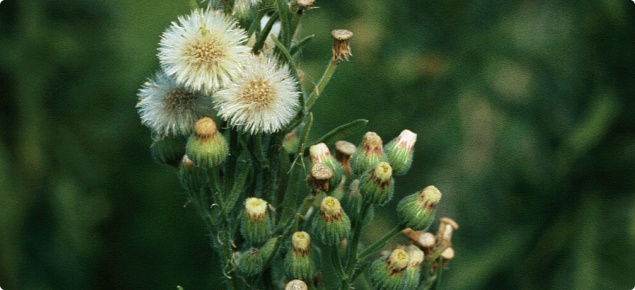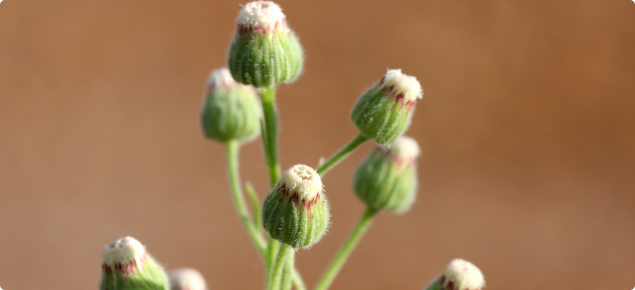Identification and attributes
There are two main species of fleabane in Australia, namely Conyza bonariensis (flaxleaf fleabane) and C. albida (tall fleabane). C. canadensis (Canadian fleabane) also occurs but is less prevalent.
Distinguishing features
Both of the common fleabane species are upright tap-rooted annuals in the daisy family. On maturity they both produce compact seed heads with a parachute of fine hairs. The light fluffy seeds are readily dispersed by wind. Flaxleaf fleabane is a grey hairy plant, growing to 1 metre (m) tall and the inflorescence (cluster of seed heads) resembles a candelabra. Mature plants of flaxleaf fleabane produce an average of 110 000 seeds each. Tall fleabane has lighter green leaves and grows to 2m.
| Characteristic | Flaxleaf fleabane (Conyza bonariensis) | Tall fleabane (C. sumatrensis) |
|---|---|---|
| Mature plant height | 1m | 2m |
| Stem branching | Branches below each pyramid of inflorescences | Branches only at the inflorescence |
| Inflorescence shape | Candelabra | Pyramid |
| Flower colour | White to pink | Greenish white |
| Leaf colour | Grey-green | Green |
Biology
Fleabane in WA can germinate throughout the year, but is most common in spring. Emergence is staggered, so it is difficult to control all cohorts of seedlings.
Flaxleaf fleabane flowers/produces seed throughout the year and the pappus on the seed enables it to be dispersed long distances by wind. Fleabane is a prolific seed producer, each plant producing up to 110 000 seeds. Of these seeds, up to 80% can be viable. The seeds do not possess dormancy so they can germinate whenever temperature and moisture requirements are met. Prevention of seed-set is vital for control.
Fleabane seeds can only emerge from on or near the soil surface (under zero or reduced tillage systems). The depth of burial affects seed survival of fleabane. When sown on the surface, 5% of the seed remains viable after 12 months. After burial at 50 millimetres (mm) and 100mm for 12 months, 10% and 15% of buried seeds maintain their viability.
Why is it a weed?
Fleabane is a major weed of fallows and competes for the vital resource of soil water in both crop and fallow phases. In WA, fleabane often germinates in spring and early summer prior to harvest. Once the crop is removed, the fleabane has no competition for light or moisture and can grow rapidly, especially with further summer rain. By the time there is a window for control, the fleabane are often large with an extensive root system and a reduced leaf area. This makes the plants tolerant to most herbicides. Large infestations of summer weeds have been implicated in reductions in available soil moisture for the following crop resulting in yield losses.
Herbicide resistance
Fleabane is very difficult to control with herbicides. Inconsistent control is often obtained with herbicide treatments, especially once plants exceed a diameter of 30mm. Where fleabane becomes a problem in fallows, weed control costs can increase by up to 80% due to the difficult nature of control.
There is confirmed resistance of flaxleaf fleabane to glyphosate in the eastern states of Australia. One biotype in New South Wales showed 32 times higher glyphosate resistance compared to a susceptible biotype. Overseas research has documented glyphosate resistant fleabane as well as resistance to Group B (chlorsulfuron), Group C (atrazine and simazine), and Group L (diquat and paraquat).



